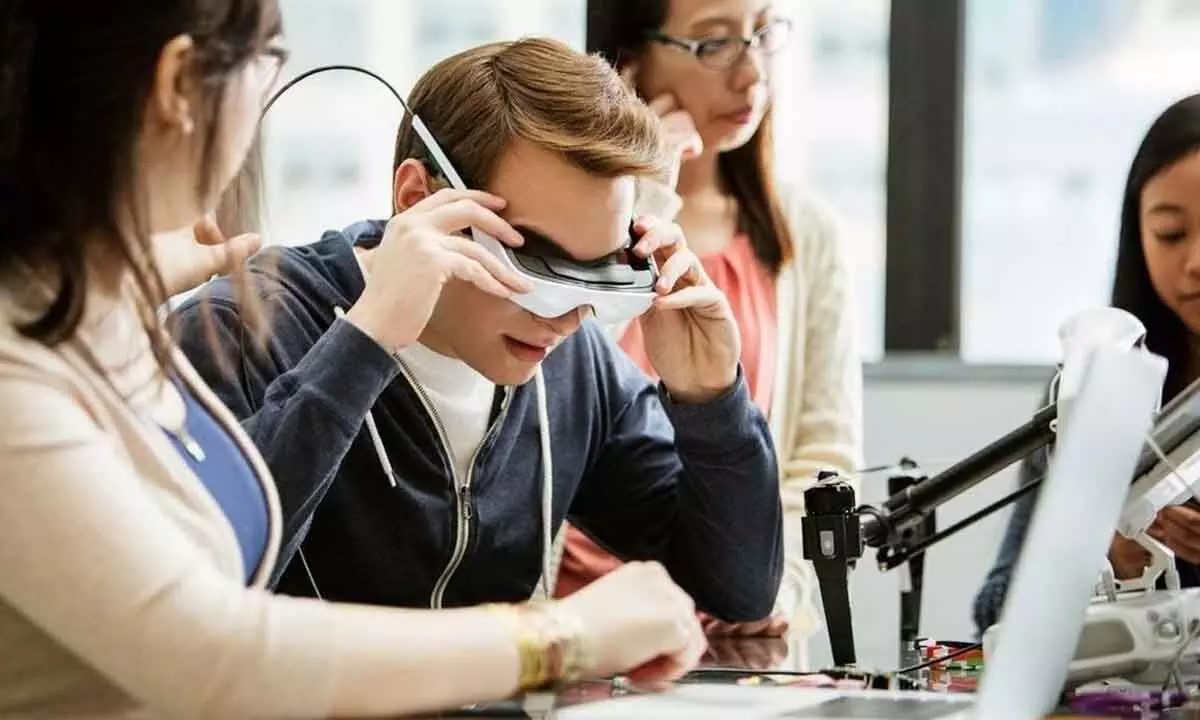Live
- Ukrainian attacks with British weapons will invite retaliation, Russia tells UK
- Indian airlines poised to capture 50% of country’s global passenger traffic: CRISL
- Entire NC unit in Ladakh's Kargil quits party to protest LS alliance
- Sharad Pawar to cast vote in Baramati after a decade
- Difference Between Business Credit Score and Personal Credit Score
- Indian Bank posts 55% jump in Q4 net profit, declares dividend of Rs 12 per share
- Govt showcases India as 365-day tourist destination at Arabian Travel Mart
- Pulwama to Poonch - Congress not learning from past mistakes, experts reckon
- ISRO moves ahead in development of 2,000 kN thrust semi-cryogenic engine
- FLiRT Covid variants: No need for panic or extra caution, say experts
Just In
The importance of technology education schools


The integration of cutting-edge educational technology in primary education is a journey that requires thoughtful consideration, continuous adaptation, and a commitment to the holistic development of young minds. One should stand as a guiding force in this journey, contributing to the evolution of primary education by fostering a harmonious blend of tradition and innovation
In the ever-evolving landscape of education, the incorporation of cutting-edge educational technology in primary education has become a topic of considerable interest and discussion. I would like to provide insights into the pragmatic aspects of this transformative journey, emphasizing the need for a balanced and informed approach to harnessing technology’s potential in the primary education sector.
Navigating educational technology in primary education
The incorporation of educational technology in primary education is not a mere trend but a response to the evolving needs of our young learners. As our society becomes increasingly interconnected and digital, it is essential to prepare the next generation for the challenges and opportunities that lie ahead. Educational technology, when applied judiciously, can enhance the learning experience, providing students with valuable skills and knowledge that extend beyond the traditional classroom setting.
Balancing tradition and innovation
While embracing the potential of educational technology, it is crucial to maintain a delicate balance between traditional pedagogical methods and modern tools. As educators, we understand that technology is not a panacea but a tool that, when used mindfully, can complement and enhance the learning journey. We emphasize the importance of preserving the essence of primary education while integrating technology to enrich the educational experience.
Understanding the educational landscape
Before delving into the specifics of educational technology, it is imperative to recognize the broader landscape of primary education. This phase is foundational, shaping not only academic competencies but also the social, emotional, and ethical dimensions of young minds. A holistic education approach considers not just the acquisition of knowledge but the development of critical thinking, creativity, and adaptability.
The role of educational technology in skill development
Educational technology, when thoughtfully integrated, has the potential to cultivate a range of skills crucial for the 21st century. Skills such as problem-solving, digital literacy, collaboration and communication are fundamental in preparing students for a future that is increasingly driven by technology. We also place a strong emphasis on leveraging educational technology to foster these skills, ensuring that our students are well-equipped for the challenges of the modern world.
Adapting to diverse learning styles
One of the inherent strengths of educational technology is its ability to cater to diverse learning styles. Every child learns differently, and technology provides a versatile platform to accommodate various learning preferences. Whether through interactive multimedia content, adaptive learning platforms, or gamified elements, educational technology can adapt to the individual needs of students, enhancing their understanding and retention of concepts.
Addressing equity and access
While the benefits of educational technology are evident, it is crucial to acknowledge and address issues related to equity and access. Not all students have the same level of access to technology outside the classroom, potentially exacerbating existing educational inequalities –With a widespread presence spanning over a hundred primary and secondary schools throughout India, our organization comprehensively acknowledges the challenge at hand. We are committed to addressing the digital divide by initiating programs that ensure inclusive implementation of educational technology, reaching every student regardless of their socio-economic status.
Professional development for educators
The successful integration of educational technology relies heavily on the proficiency of educators. Educators should undergo training programs to enhance their technological skills, enabling them to harness the full potential of educational technology and create engaging and effective learning experiences for their students.
Challenges in implementation
Implementing educational technology in primary education is not without its challenges. Adequate infrastructure, teacher training and ongoing technical support are vital components of a successful integration strategy. Acknowledging these challenges, there should be a commitment to invest in the necessary resources to ensure a seamless and effective implementation of educational technology in institutions.
The evolving landscape of educational technology
Looking ahead, the landscape of educational technology is poised for further evolution. As we explore emerging trends such as augmented reality, virtual reality, and artificial intelligence, it is crucial to approach these advancements with a discerning eye. The focus here is not on the promotion of technology for its own sake but on leveraging it as a tool to enrich the educational experience. By adopting a balanced and informed approach, we aim to empower young minds with the skills, knowledge and resilience needed to thrive in a rapidly changing world.
In conclusion, the integration of cutting-edge educational technology in primary education is a journey that requires thoughtful consideration, continuous adaptation, and a commitment to the holistic development of young minds. One should stand as a guiding force in this journey, contributing to the evolution of primary education by fostering a harmonious blend of tradition and innovation.
(The author
is CEO, Zee Learn Ltd)

© 2024 Hyderabad Media House Limited/The Hans India. All rights reserved. Powered by hocalwire.com






